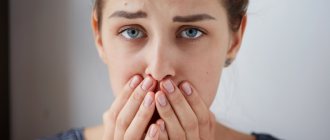Human fears can be inexplicable, but sometimes they can be understood by almost everyone. There are a huge number of them and some of them are necessary for survival, but there are those that spoil life and deprive us of a lot of pleasure. Fear of the camera is not very common these days, however, there are severe forms of phobia in which the mere sight of a camera causes a person to panic.
What is the name of camera phobia?
The fear of the camera is called autogonistophobia, translated from Greek the prefix “αὐτός-” means oneself, “αγωνιστής” means character, actor, fighter, “φόβος” means fear.
Nowadays, phobia is more common among older people. Modern young people, and even more so children, are less susceptible to it. This is due to the fact that digital video cameras and cameras are built into the phones of almost every schoolchild. People grow up with this, they take selfies, photograph friends many times a day - there is much less “seriousness” in this than before.
There is another side of the coin - developed Internet technologies allow any person (for example, a schoolchild) to post a recording on social networks or video hosting that can disgrace him in front of a large audience. However, just recently, filming with a video camera was tantamount to performing on stage and there was more reason to be afraid of it.
It is worth noting that autogonistophobia and photophobia are not synonyms. However, people suffering from photophobia are afraid of being photographed with a flash, but the reasons for this will be different from autogonistophobia. Let's talk about them in detail next.
Can a photographer help you relax before a photo shoot?
Mutual understanding is a basic condition for obtaining a high-quality result of a photo shoot. Therefore, the first thing a client needs to do is find “his” master. Social networks and personal blogs today have become the accessible business card of every professional.
Just look through the photographer’s works, understand whether you like his artistic taste, his “handwriting” - and choose the one with whom you are on the same wavelength.
Next, you need to discuss in detail the expectations from the photo shoot. The client reveals his request, the photographer shares his vision. If you don’t like something, be sure to discuss it.
It happens that the master demands completely inappropriate roleplaying from the model - you have the right to say “that’s not me.” It happens that a client wants to make an outright collective farm or boring thing - the master has the right to give professional advice that it will not work.
A detailed casual conversation over coffee or via video call will help you get a little closer, get used to each other and know what to expect on the shoot. Confidence in mutual understanding removes tensions.
Third, the psychological atmosphere during the set. Gold is the master who knows how to organically joke, make the model laugh, give a natural compliment, explain what really suits the hero of the set, what is fashionable now.
Encouragement ignites enthusiasm and engages the model in the shoot as if it were an exciting game.
Advice: you should choose a person you know to collaborate with only when you are in a good close relationship.
In another situation, it will be easier to relax and be yourself in front of a stranger than in front of a person with whom you will still see and greet in the future. This is especially true for psychological, nude and role-playing sets.
Causes of fear
Fear of the camera may be based on a serious mental disorder called body dysmorphic disorder. It means being overly concerned about one's appearance, exaggerating physical defects, or even making them up.
People who are biased about their appearance may also be afraid to be photographed. Low self-esteem is the basis for autogonistophobia. Therefore, not every person who is afraid of the camera suffers from dysmorphophobia; ordinary self-doubt or negative experience can provoke fear.
A bad experience may be associated with childhood memories - a bright flash, someone else's photographer uncle - all this could frighten and leave a mark on the memory. In addition, photographs where a person turned out poorly could traumatize the teenage psyche. In order not to experience grief, a person refuses to shoot altogether.
It is important to understand that in order to look good in photos and videos, you need to practice this. Not everyone is naturally photogenic, and to get good photos, you need to take a lot of bad ones.
The cause of autogonistophobia can be character traits, for example, natural shyness. This personality trait also has a controversial origin, some believe that it is transmitted genetically, others argue that it is just a lack of social skills, for others, a shy person is a neurotic who is unable to resolve his internal conflict. One way or another, a shy person may experience fear in front of the camera.
Other reasons include prejudice. People prone to superstitions, who take magic, paranormal phenomena and other mythology seriously may be afraid of photo and video filming. Among such people, there is a widespread belief that the camera is controlled by the devil and can take away the soul. Some people who believe in damage and curses do not want photographs of them to exist in which they can perform some rituals.
Psychological explanation of fear
The psychological explanation here may be the following: a person is very afraid of outside opinions. And this, in turn, means that he is “at odds” with himself. It is completely natural that everyone wants to look good and be liked by others. This becomes a problem when the view of an outside viewer completely determines a person’s opinion about himself.
Self-perception is formed in early childhood. Overprotective or overly demanding parents can contribute to the development of autogonistophobia in adulthood. Overprotection creates a constant disturbing background in which the child grows up. And increased demands on the part of adults force a person to subsequently treat himself and others the same way.
In the issue of fear of the camera, this is especially acute precisely because there is an imprinting effect. Society presents us with certain standards, “how it should be done.” Photos of models, videos of artists - often it looks impeccable, and a person, looking at his footage or recordings, begins to experience a feeling of inferiority, inadequacy, and begins to be afraid to try again. It is important to realize that perfect photos in glossy magazines are the joint work of professionals:
- photographer,
- illuminator,
- stylist,
- makeup artist,
- hairdresser,
- graphic editor,
- models.
For them, creating a photograph or video is a job. I think many of you have more than once seen photographs taken by paparazzi in which famous people, beloved beauties and handsome men look simply scary. Therefore, it is very strange to be afraid to act for fear of looking “not perfect”, when even a superstar “not at work” looks very ordinary.
Getting rid of fear
The psychological explanation for being afraid of the camera mainly comes down to dissatisfaction with one's appearance and social beliefs that do not allow one to step out of line. Correcting one's behavior and perception of one's nature within the framework of generally accepted norms is a long process and requires painstaking work from the patient. If you are severely upset, it is better to seek help from a psychologist. In mild form, autogonistophobia can be treated independently. You just need to find a photographer with whom you feel comfortable and work on favorable angles.
It will be more difficult to deal with a complex phobic disorder, especially if the symptomatic picture includes panic attacks at the sight of cameras, a fear of mirrors and other related disorders develop. First, they look for the cause of neurosis. The second stage will be the adaptation of the individual to society. People with low self-esteem do not allow themselves any liberties in clothing; they try not to stand out from the crowd, fearing to cause a resonance in society. To begin with, such patients are offered to update their wardrobe and choose a new image.
Fear is the body's reaction to a potentially life-threatening situation, so treatment is aimed at gaining a person experience that allows the body to understand that photography will not harm it. If necessary, the doctor may prescribe mild herbal-based sedatives or vitamins to improve the functioning of brain centers and restore nerve cells.
Leaving the comfort zone
In the presence of a phobic disorder, the body creates a comfort zone for itself in which it feels safe. By avoiding certain situations that are stressors, the patient believes that he has complete control over it. This is not so, he deprives himself of a certain part of life, does not move forward, but stands in one place.
To get out of their comfort zone, patients are encouraged to find an activity they like and expand their social circle by enrolling in courses.
The main thing is to ensure that the individual begins to perceive himself as an individual, as a separate functional unit of the society in which he is located. Then adaptation practice begins. The photographer takes part in this stage. This stage can help significantly improve self-esteem. Today, not everywhere you can find a good photographer who can take a beautiful photo, so the first experience of communicating with people in this profession remains the last. A beautiful photograph will help the patient understand that he can look attractive.
Comparison with supermodels
This is one of the points about imposing on society an opinion about generally accepted standards of beauty. Almost every person has an inferiority complex and the feeling that such a result as in glossy magazines will never be achieved. As mentioned above, it is important to realize that they are all specially painted, the angle is chosen correctly, any professional model knows its pros and cons, so it can skillfully hide its shortcomings in the photo. In addition, most photographs are processed through Photoshop, and only then put into print. Gloss is far from the best option for motivation.
Psychologists advise looking at photos of people who work in the field of “XXL model” or those who have lost a lot of weight, are now not embarrassed to flaunt their body with stretch marks, but are proud of the result and do this in order to motivate other people, not paying attention to comments from envious people. External beauty is not as important as internal beauty.
Someone's mind
Get rid of negative thoughts about other people's opinions from your head; if you really want to, you can not show your photos to friends and acquaintances, or shut their mouths by pointing out their shortcomings. Think about how you feel, you want to capture a good moment in your life to leave a memory for yourself, your children, your grandchildren.
Before the photo shoot, do a beautiful hairstyle, makeup, and put on clothes that make you feel stunning. Think about the theme of the photo shoot, consult with the photographer. If you are worried that the photographer will be dissatisfied with your work as a model, remember: he is also a person and may also be shy and worried before meeting you.
Look at the photo from the other side
Look at the photos that you think are ugly from the other side. Try to approach them with humor.
Canons of religion
The time is over when women were burned at the stake at the direction of the church and scientists were executed on the scaffold, accused of practicing alchemy. Just because you take a photo, the end of the world will not come and “the demon will not swallow your soul.” Watch less of all kinds of mystical TV shows. Remember that on television all information is for sale. And the price always includes scandals, blood, conflicts and other negative things. If everyone could inflict mortal damage on a photograph, then there would be no people left on our planet.
Relaxation
One of the psychological techniques is teaching relaxation methods. This includes breathing exercises that help you control your emotional and physical state. Learn to quickly abstract yourself from the world around you and drive away negative thoughts, filling your mind with positivity. In a stressful situation, imagine a place where you feel protected, do not experience discomfort, think about what brings you joy.
Relaxation will help relieve the symptoms of a phobia.
Breathing control helps to shift all attention from the obsession with being ugly in a photo to a positive direction. Inhale and exhale slowly, feel how the body is filled with oxygen, lightness comes, and bad thoughts fade into the background. This approach will help in any situation, not just before a photo shoot.
Focus on positive qualities
A person spends his entire life learning and gaining certain experience; we are not born with the ability to cook, sing, dance, write, read, etc. A person acquires all these skills, if desired, while growing up. So filming should be perceived as growing above yourself, gaining a positive experience. Focus on what you do best, your inner potential.
Symptoms and signs of fear
The main symptom is, of course, a pathological fear of being filmed or photographed. At the sight of the camera, a person is overcome with horror. Signs of a phobia vary depending on the severity: from embarrassment and mild discomfort to a panic attack. First of all, the following signs become noticeable to others:
- stiffness,
- clumsiness,
- redness of the skin.
A person experiences symptoms from the autonomic nervous system in the form of:
- increased heart rate,
- dizziness,
- nausea,
- dry mouth,
- limb tremors,
- other classic signs of phobic disorders.
Some people suffering from autogonistophobia are inclined to explain their fear with some strange theories about the dangers of photography. Another convinces himself and others that constant selfies are the lot of slackers. It is quite difficult to look into yourself and admit that you are afraid of something, allow it to be and answer yourself what the real reason is. And this is where the path begins that will help overcome the fear of the camera.
Final part
Fear of video cameras is one of the fairly common phobias. It appears for various reasons and deprives a person of many of the joys of life, not allowing him to feel comfortable in society.
Treatment of a phobic disorder requires the patient’s painstaking work on himself and the desire to develop. An untreated phobia can cause the development of fear of mirrors, persecution mania, and schizophrenia. Don’t deny yourself the opportunity to live a full life - get rid of fears in order to be able to capture your best moments in photos. Remember that you can always turn to specialists who will help you cope with this fear.
How to overcome your fear of the camera
The fear of being filmed, of course, is not the most “difficult” phobia, however, in the modern world, where soon instead of an essay at school they will be asked to record a video blog on the topic “The controversial image of the main character of Leo Tolstoy’s novel,” the fear of the camera is an increasingly greater problem.
I am deliberately exaggerating, but there is some truth in this; modern trends increasingly emphasize the importance of appearance, the ability to “sell yourself” and interact with the audience. There is a fear of not meeting standards (hence the amazing success of marketing programs for sales of anti-cellulite creams, etc.), and the fear of being photographed is a natural consequence, non-compliance with standards, which is recorded over time.
Working with accepting yourself for who you are is a difficult task that is sometimes beyond the power of a person. That is why there are psychologists and psychotherapists who help cope with this problem. Most often, the fear of the camera is due to low self-esteem, the inability to form one’s opinion without taking others into account. One way or another, a lack of social skills often accompanies autogonistophobia and is its cause or consequence.
Severe forms of phobia, in which a person may become hysterical at the mere sight of a camera, are effectively treated by psychotherapists using a complex of pharmacotherapy (sedatives, antidepressants, mood stabilizers, etc.) and psychotherapy. The most commonly used approach is the cognitive behavioral approach. It has the best results in getting rid of phobic disorders. The principle of this type of psychotherapy is that it operates on two fronts: working with beliefs and attitudes, which are often not realized until you speak them out; and behavioral work, where a person is gradually taught to be in a “dangerous” situation and control it.
You can overcome your fear of the camera on your own if the disorder is not in a critical phase and your fear is limited to stiffness, discomfort and clumsiness. In order to cope with this state, you need to immerse yourself in it, but do it in the most calm environment possible.
Ask someone close to you to photograph you several times, try different angles, make faces, try to relax. Focus on the fact that you are just playing around, you are not trying to look stunning. Allow yourself to be who you are. If such events no longer cause you stress, contact a professional and do a photo shoot for yourself. Tell him that you are afraid of acting and that turning to him is a serious overcoming for you. A good photographer will definitely help you relax during the shooting and take photographs that will leave pleasant memories.
Body dysmorphomania
Dysmorphophobia and dysmorphomania - these mental disorders have the same causes, but the second disorder is more serious. The patient’s belief in the presence of a physical defect is delusional and cannot be completely cured. Delusional dysmorphomania may indicate the onset of schizophrenia and manifests itself as an obsessive belief in the presence of an imaginary or extremely aggravated physical defect in visible parts of the body (nose, ears, lips, mouth, etc.). The painful condition is accompanied by delusional ideas, hallucinations, signs of mental automatism, panic fear, etc. Psychotherapists call criticism or name-calling in childhood the main cause of dysmorphomania.
Signs of a painful condition:
- gloomy mood;
- desire to hide true feelings;
- desire to correct physical defects.
Patients convince doctors that they are right. They use the services of plastic surgeons.
Plastic surgery for dysmorphomania
Even the most successful surgical intervention does not bring relief - they continue to suffer. This is manifested by a state of increased anxiety, panic attacks, signs of persistent depression and thoughts of suicide.
An obsession with correcting an imagined flaw forces a person to undergo a series of plastic surgeries. There are cases where patients themselves removed defects or inserted implants, putting their health at risk. Specialists must distinguish between body dysmorphomania and other mental disorders: schizophrenia, pre- and postoperative depression.
What to do if you suddenly find yourself afraid of the camera
Any fear does not arise just like that. It is important to try to understand exactly when it appeared, what contributed, what was the “trigger”. There are often situations when a phobia has formed due to some kind of intrapersonal contradiction, from which a person cannot find a way out for a long time.
Thus, the fear of cameras is only a “distraction” for the psyche, which cannot be permanently in a stressful state. If you discover fear in yourself, cannot explain its nature and are unable to control its manifestations, then the best solution would be to seek advice from a psychologist.
If your work is directly related to filming and photography and you have not experienced any symptoms of autogonistophobia before, then it is likely that you need to take a break. Lack of regular vacations and workaholism in any industry can lead to professional burnout.
A young blogger talks about the symptoms of camera fear and how you can get rid of this illness yourself in this video:
The role of phobias in human life
A phobia affects a person's life. A change in personality is not always noticeable to others, but suppressed fear changes a person's perception. Fear distorts reality: the victim of a phobia must feed internal fear and seek confirmation of fears. This is the only way she can justify internal tension and temporarily reduce it.
Anxiety is the beginning of fear. This is a state in which a person cannot concentrate on one activity, he is distracted and confused. As concentration decreases, memory deteriorates. A phobia, for whatever reason it develops, affects the victim’s relationship with society. After experiencing trauma or for subjective reasons, the victim encourages the phobia, and, not wanting to justify himself to loved ones, chooses voluntary removal and imprisonment.
Any phobia is characterized by a feeling that an irreparable disaster will soon occur. The victim lives in anticipation of a threat: for the subconscious, negative thoughts and fears are perceived as an already existing danger. The severity of the reaction directly depends on the personal qualities of the victim, how stable and self-confident she is. Fear of objects or certain events can begin in childhood or adulthood.









